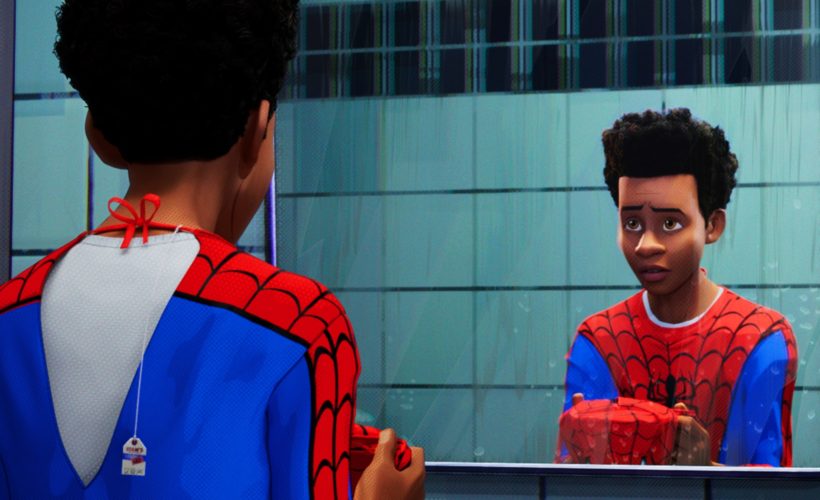Nothing has followed Spider-Man’s long and varied character history quite like one single phrase: “With great power comes great responsibility.” Generally attributed to Peter Parker’s Uncle Ben, it long ago left the world of Marvel Comics to become a general-purpose exhortation, deployed by everyone from heads of state to the Supreme Court. At this point, it is the webslinger. It’s also barely even winked at in Spider-Man: Into the Spider-Verse. And that’s a good thing. The new animated movie understands that with seven big-screen appearances since 2002, old tropes don’t necessarily need to be repeated. Besides, if you’re going to make a Spider-Man film, the real responsibility is to do something worthwhile with him—to make him the hero his fans need. Into the Spider-Verse is that movie.
Spearheaded by Phil Lord and Chris Miller, the duo that managed to wring actual hilarity out of both 21 Jump Street and Legos, Into the Spider-Verse removes Peter Parker as the focus of the story and instead offers up Miles Morales (voiced by Shameik Moore), the Afro-Latino teenager who became Spider-Man in the Marvel comics in 2011. That doesn’t mean that Peter Parker doesn’t exist in this version; he just lands in the movie from another dimension. In this movie Morales is the hero, and all the other Spideys out there—Spider-Gwen, Spider-Ham, Spider-Man Noir, Peni Parker—come into his world from another part of the multiverse thanks to the machinations of Kingpin (Liev Schreiber) and Doc Ock (Kathryn Hahn). It’s a whirlwind, one that gets more ridiculously funny as each time a new Spidey shows up and launches into their own “I was bitten by a radioactive spider…” story.
But that’s just the setup. The punchline, if it can be called that, is that by introducing so many Spideys rather of just re-introducing the old one, Spider-Man: Into the Spider-Verse has made its titular character(s) far more compelling than they have been in years—and made a far, far better movie in the process. (Spider-Man: Homecoming may be a delight, but I never once wondered where it was going. No one did.) By featuring a new Spidey, it gets to introduce audiences to an artistic Brooklyn kid trying to fit in at a school for gifted students instead of the same Queens-bred photographer they’ve seen so many times before. And by being an animated film, it gets to paint his world in a million and one different ways that feel far more vibrant than any CGI-enhanced Green Goblin.
And really, the animation—itself a throwback to the many non-film incarnations of the character—is astounding. Directed by Bob Persichetti, Peter Ramsey, and Rodney Rothman for Sony Pictures Animation, it’s full of bold colors that make it look like a comic book drawn in 3-D or spray-painted on the side of a subway car. There’s a vibrance, a lightness that’s just not possible with live action. There’s also a certain slapstick—a sense of playfulness that Spidey can easily benefit from, but has never been able to have in a film until now.
Then there’s the cast. This, more than anything, is Into the Spider-Verse‘s biggest strength. Ever since Miles Morales was introduced into the Marvel canon by writer Brian Michael Bendis and artist Sara Pichelli, folks have been gunning for a big-screen adaptation of his story. Some decried this move away from Peter Parker to a new Spidey as the work of social justice warriors (oh, internet…), but everyone else saw it for what it was: a call for a hero who looked like many of the young people who looked up to him. For decades the New York of the Marvel movies has been protected by a group of super-people—Tony Stark, Steve Rogers, Bruce Banner—that didn’t necessarily reflect the population of the city itself. Putting Miles (not to mention Spider-Gwen and Peni Parker) front and center rights that wrong.
Recently, WIRED asked nerd encyclopedia Kevin Smith to break down all of the various screen incarnations of Spider-Man. In his exegesis, he noted that Stan Lee would often say “the real charm of that character … is Spider-Man was covered from head-to-toe. Once he’s in the costume, you don’t know who he is. You don’t know what he is. You don’t know if he’s a boy, a girl, what race, creed, color, or anything. … Any kid reading that book can see themselves as the character. It’s kind of ingenious; it’s kind of wonderful.” This vision, Smith notes, becomes “writ large” in the character of Miles Morales.
I don’t know if the creators of Spider-Man: Into the Spider-Verse were thinking of this specifically when they made their film. The idea, however, came through. In what will likely be one of Lee’s final cameos in a Marvel film (he passed away last month), the iconic comics creator shows up as the purveyor of a costume shop—the very one Morales enters looking for his first Spider-Man costume. (In this version of the multiverse, everyone knows who Spider-Man is and the original Peter Parker has died.) The suit, Morales worries, might not fit. Taking on the mantle of one of the city’s most beloved heroes isn’t easy; it’s a big suit to fill. Not to worry, says Stan the shopkeeper: “they all fit—eventually.”
More Great WIRED Stories
- Facebook exposes nonprofits to donors—and hackers
- What the stock selloff tells us about the future of tech
- The math whiz designing large-scale origami structures
- What’s the fastest 100 meter dash a human can run?
- The music obsessives who tape your favorite concerts
- ? Looking for the latest gadgets? Check out our picks, gift guides, and best deals all year round
- ? Want more? Sign up for our daily newsletter and never miss our latest and greatest stories
Source:WIRED










